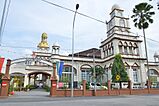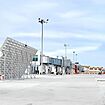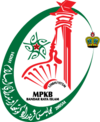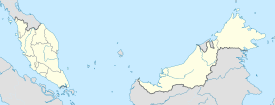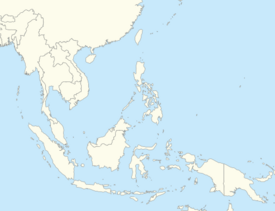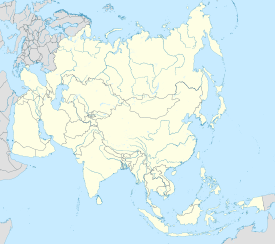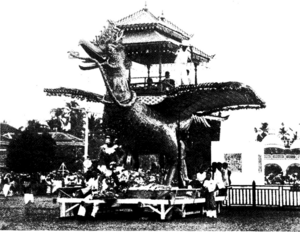Kota Bharu facts for kids
Quick facts for kids
Kota Bharu
Koto Baru
|
|||
|---|---|---|---|
|
Town, state capital and district capital
|
|||
| Town of Kota Bharu Bandar Kota Bharu |
|||
| Other transcription(s) | |||
| • Jawi | كوتبهارو | ||
| • Chinese | 哥打峇鲁 (Simplified) 哥打峇魯 (Traditional) Gēdǎ Bālǔ (Hanyu Pinyin) |
||
| • Tamil | கோத்தா பாரு Kōttā Pāru (Transliteration) |
||
|
From top, left to right:
Kota Bharu skyline, Sultan Ismail Petra arch, Tuan Padang roundabout clock tower, Aeon Mall, Kota Darulnaim Complex, World War Memorial, Istana Jahar, the Kelantan Museum, the Muhammadi Mosque, Sultan Ismail Petra Airport, and TROIKA Residence. |
|||
|
|||
| Nicknames:
The Islamic City (Bandar Raya Islam), The Cultural City (Kota Budaya)
|
|||
| Country | |||
| State | |||
| District | |||
| First settled | 1844 | ||
| Establishment of the town council | 1936 | ||
| Establishment of the town board | 1971 | ||
| Municipality status | 1 January 1978 | ||
| Founded by | Sultan Muhammad II | ||
| Government | |||
| • Type | Municipal council | ||
| • Body | Kota Bharu Municipal Council | ||
| Area | |||
| • Total | 115 km2 (44 sq mi) | ||
| Population
(2022)
|
|||
| • Total | 568,900 | ||
| • Density | 4,947/km2 (12,810/sq mi) | ||
| Time zone | UTC+8 (MST) | ||
| • Summer (DST) | Not observed | ||
| Postcode |
15xxx
|
||
| Area code(s) | +60-09-7 | ||
Kota Bharu (also called KB) is a lively city in Malaysia. It is the capital city and royal home of the state of Kelantan. You can find it in the northeastern part of Peninsular Malaysia, close to where the Kelantan River meets the sea.
This city has many interesting places to visit. You can see beautiful religious buildings and different museums. There are also old royal palaces with unique designs. The Sultan and Sultanah of Kelantan still live in some of these palaces. You can see them from outside, but you can visit other former royal buildings.
You can reach Kota Bharu by train at the nearby Wakaf Bharu Terminal Station. This station is in the town of Wakaf Bharu, just across the Kelantan River. The city also has an airport called Sultan Ismail Petra Airport, located in Pengkalan Chepa.
Contents
What Does Kota Bharu Mean?
The name Kota Bharu means "new city" or "new castle/fort" in the Malay language. Sometimes, you might see the city's name written as Kota Baharu.
A Look at Kota Bharu's History
Kota Bharu was first started in the late 1800s. Before it became a city, it was home to Kelantan's Royal Palace. In 1844, Sultan Muhammad II of Kelantan made it the state capital. He wanted a new capital built to honor him.
Before this, Kota Bharu was known as Kuala Kelantan. The capital of Kelantan used to be split into two places: Kota Kubang Labu and Kota Pengkalan Datu. In the 1800s, Kelantan was a rich and busy state. It had between 30,000 and 50,000 people, including many Chinese residents.
The state produced many goods like gold, tin, black pepper, and rice. Kota Bharu was a great trading spot because it was right next to the Kelantan River.
Kota Bharu During World War II
During World War II, an important event happened near Kota Bharu. On December 8, 1941, Japanese forces landed at Pantai Sabak, about 10 kilometers from the city. This was the start of the Battle of Kota Bharu, the first battle of the Japanese Invasion of Malaya.
The Japanese army took control of the city. They then fought the British in the jungle and eventually captured Singapore.
Becoming a Cultural and Islamic City
On July 25, 1991, the late Sultan Ismail Petra declared Kota Bharu the "Cultural City." He did this because of the city's rich history and its special local arts and cultures.
Later, on October 1, 2005, the Kelantan State Government renamed Kota Bharu the "Islamic City" (Bandar Raya Islam). This was part of their "Developing With Islam" (Membangun Bersama Islam) policy.
People of Kota Bharu
Most people in Kota Bharu are Kelantanese Malay. They speak the Kelantan Malay dialect. There is also a good number of Chinese people living here.
Religions in Kota Bharu
About 93% of the people in Kota Bharu are Muslim. The rest of the population includes Buddhists, Hindus, and Christians. Most of the Chinese community in the city practice Buddhism.
Culture of Kelantan
The culture in Kelantan is very unique compared to other states in Malaysia. It also has some influences from Thailand because it is so close to the border.
Delicious Food in Kota Bharu
When you visit Kota Bharu, you must try the local food! Some popular dishes are Nasi berlauk, nasi dagang, nasi lemak, and nasi kerabu. Sweet cakes, called kuih, are also very popular among the people of Kelantan. Other tasty foods include nasi tumpang, etok, akok, lompat tikam, and netbak.
Kota Bharu's Climate
Kota Bharu has a tropical monsoon climate. This means it's usually warm and humid. The city gets a lot of rain, especially from August to January. It also has slightly cooler temperatures between December and February. On average, Kota Bharu receives about 2600 millimeters (102 inches) of rain each year.
| Climate data for Kota Bharu (1991–2020 normals) | |||||||||||||
|---|---|---|---|---|---|---|---|---|---|---|---|---|---|
| Month | Jan | Feb | Mar | Apr | May | Jun | Jul | Aug | Sep | Oct | Nov | Dec | Year |
| Record high °C (°F) | 33.4 (92.1) |
33.0 (91.4) |
34.9 (94.8) |
35.6 (96.1) |
36.4 (97.5) |
35.6 (96.1) |
35.7 (96.3) |
35.2 (95.4) |
35.0 (95.0) |
34.8 (94.6) |
33.6 (92.5) |
32.4 (90.3) |
36.4 (97.5) |
| Mean daily maximum °C (°F) | 29.5 (85.1) |
30.4 (86.7) |
31.4 (88.5) |
32.6 (90.7) |
33.0 (91.4) |
32.7 (90.9) |
32.3 (90.1) |
32.2 (90.0) |
31.9 (89.4) |
31.1 (88.0) |
29.8 (85.6) |
29.2 (84.6) |
31.3 (88.3) |
| Daily mean °C (°F) | 26.3 (79.3) |
26.7 (80.1) |
27.4 (81.3) |
28.4 (83.1) |
28.5 (83.3) |
28.1 (82.6) |
27.7 (81.9) |
27.5 (81.5) |
27.3 (81.1) |
27.0 (80.6) |
26.4 (79.5) |
26.3 (79.3) |
27.3 (81.1) |
| Mean daily minimum °C (°F) | 23.6 (74.5) |
23.5 (74.3) |
24.0 (75.2) |
24.7 (76.5) |
24.9 (76.8) |
24.6 (76.3) |
24.3 (75.7) |
24.0 (75.2) |
23.9 (75.0) |
24.0 (75.2) |
23.9 (75.0) |
23.8 (74.8) |
24.1 (75.4) |
| Record low °C (°F) | 16.7 (62.1) |
17.8 (64.0) |
17.8 (64.0) |
18.3 (64.9) |
21.7 (71.1) |
21.1 (70.0) |
20.6 (69.1) |
21.1 (70.0) |
20.6 (69.1) |
20.6 (69.1) |
18.9 (66.0) |
18.9 (66.0) |
16.7 (62.1) |
| Average precipitation mm (inches) | 149.9 (5.90) |
69.0 (2.72) |
140.3 (5.52) |
92.5 (3.64) |
115.8 (4.56) |
137.7 (5.42) |
155.0 (6.10) |
157.9 (6.22) |
163.3 (6.43) |
267.4 (10.53) |
676.9 (26.65) |
572.4 (22.54) |
2,697.9 (106.22) |
| Average precipitation days (≥ 1.0 mm) | 9.5 | 4.7 | 6.7 | 5.8 | 8.5 | 9.6 | 10.2 | 12.5 | 12.2 | 15.7 | 20.5 | 18.4 | 134.3 |
| Average relative humidity (%) | 84 | 84 | 83 | 82 | 83 | 83 | 83 | 84 | 84 | 86 | 88 | 87 | 84 |
| Mean monthly sunshine hours | 161 | 190 | 207 | 214 | 194 | 186 | 184 | 187 | 187 | 174 | 139 | 130 | 2,153 |
| Source 1: World Meteorological Organization | |||||||||||||
| Source 2: Ogimet Deutscher Wetterdienst (humidity) | |||||||||||||
Getting Around Kota Bharu
Public Transport
You can use Grab Car services in Kota Bharu. They are available 24 hours a day since April 2017.
The city is served by Sultan Ismail Petra Airport (KBR). This is the busiest airport on the east coast of Peninsular Malaysia.
The closest train station is the Wakaf Bharu station. It is on the other side of the river, about 6 kilometers from the city center. A new train station for the MRL East Coast Rail Link is being built near Kampung Tunjong.
Roads and Highways
Highway 8 is the main road that connects Kota Bharu to Kuala Lumpur, the capital of Malaysia. Highway 3 links Kota Bharu to Pasir Mas and the Thailand border to the west. It also connects to cities like Kuala Terengganu, Kuantan, and even Johor Bahru to the south.
You can also get to Penang using Highway 4. The Kota Bharu–Kuala Krai Expressway, also called the People's Expressway, is a planned highway. It will connect Kota Bharu to Kuala Krai in southern Kelantan. This project is part of the Central Spine Road and is expected to be finished by 2020.
Learning in Kota Bharu
Kota Bharu has many schools and universities. Some well-known places for higher education include Open University Malaysia and Universiti Tun Abdul Razak.
There are also many national schools, private schools, and Islamic religious schools. You can find Chinese primary and secondary schools, and technical secondary schools too.
Shopping in Kota Bharu
Kota Bharu is a great place to shop! The most famous shopping spot is Siti Khadijah Market. Most of the sellers there are women. Right next to this market is the Kota Bharu Trade Centre (KBTC), which opened in 2009.
Other shopping centers in Kota Bharu include KB Mall, Kota Seri Mutiara, and AEON Mall. You can also find large supermarkets like Lotus's (formerly Tesco) and Mydin Mall.
Fun Things to Do in Kota Bharu
Beaches
The beaches near Kota Bharu face a challenge from strong waves. The community is working to protect the coastline by placing many large rocks to break the waves. Because of this, people often visit beaches further south for regular beach activities. The most famous beach in Kota Bharu for tourists is Pantai Cahaya Bulan.
Wreck Diving
Diving is a newer activity in Kota Bharu. There is one dive shop that offers trips to interesting sites. One popular spot is the wreck of the IJN Awazisan Maru. This Japanese transport ship was the first ship to sink in the Pacific War. The wreck is only a 30-minute boat ride from a jetty near Kota Bharu.
Famous People From Kota Bharu
Many talented people come from Kota Bharu, including:
- Academics:
* Omar Abdul Rahman * Nik Safiah Karim
- Athletes:
* Badhri Radzi (footballer) * Hafiz Hashim (former national badminton player) * Khairul Fahmi Che Mat (national football goalkeeper) * Luqman Hakim Shamsudin (footballer) * Roslin Hashim (former national badminton player)
- Entertainers:
* Aedy Ashraf * Izzue Islam * Misha Omar * Julia Rais * Neelofa
Kota Bharu's Sister Cities
Kota Bharu has special connections with two other cities around the world. These are called "sister cities."
|
See also
 In Spanish: Kota Bharu para niños
In Spanish: Kota Bharu para niños





